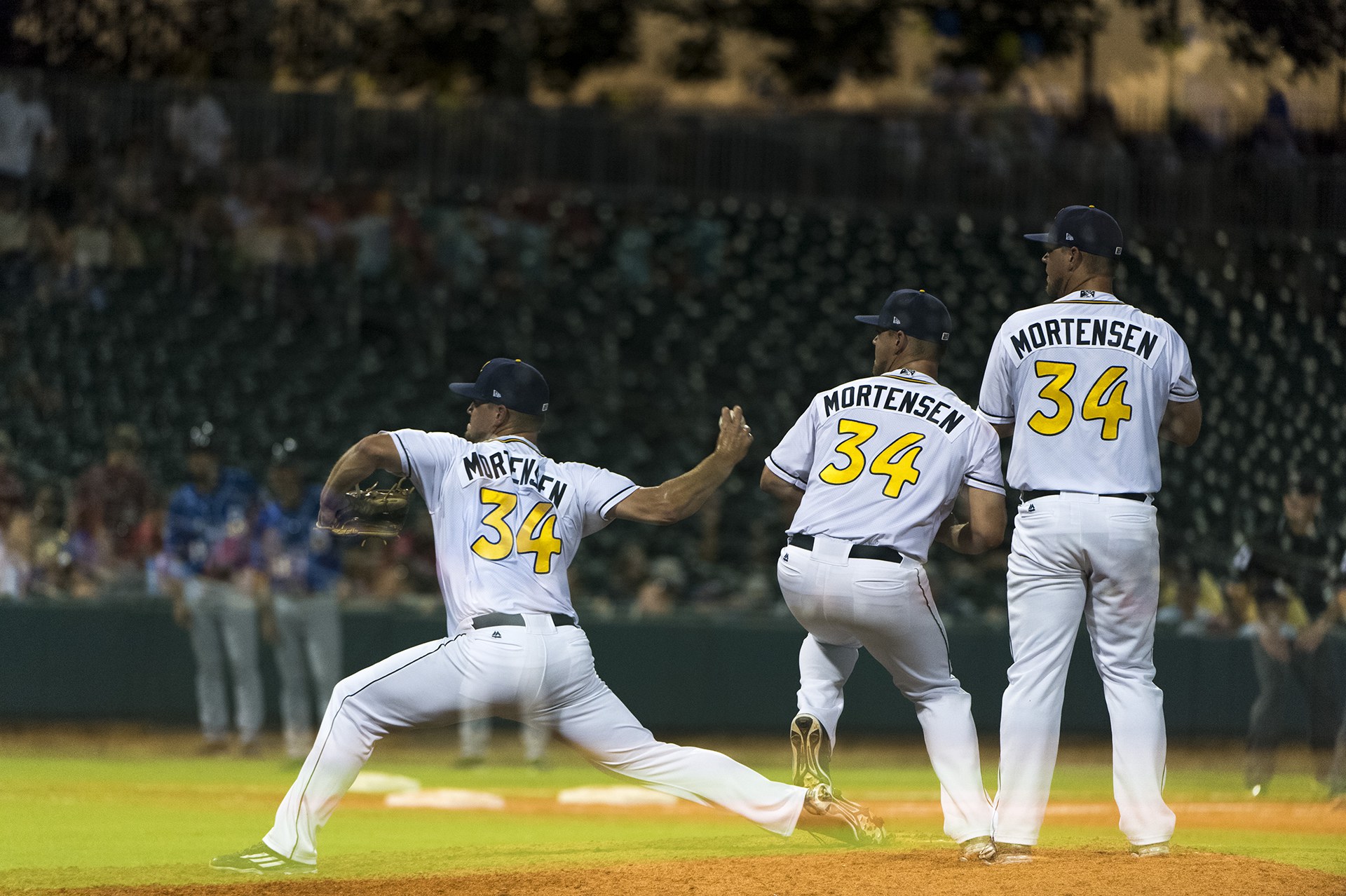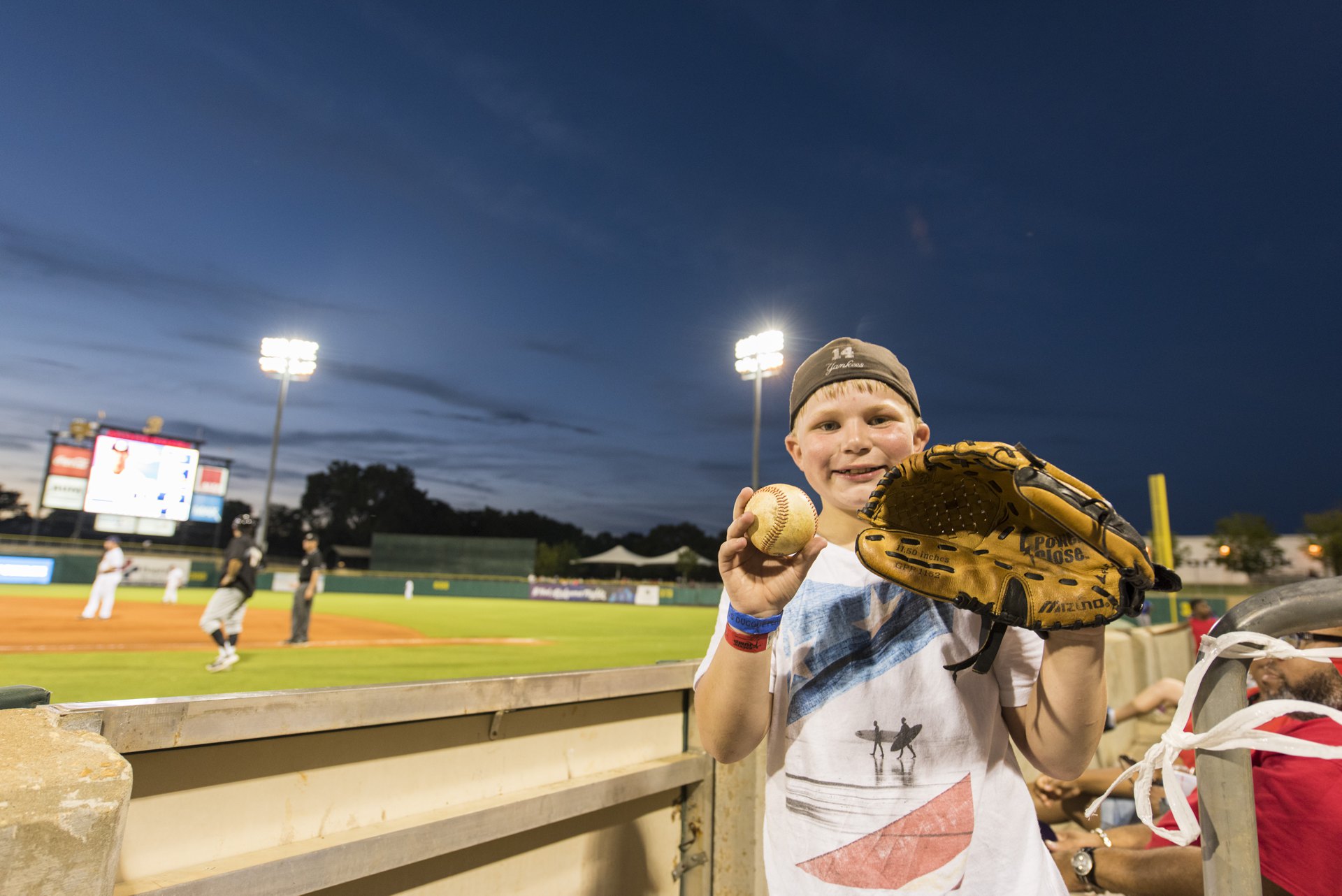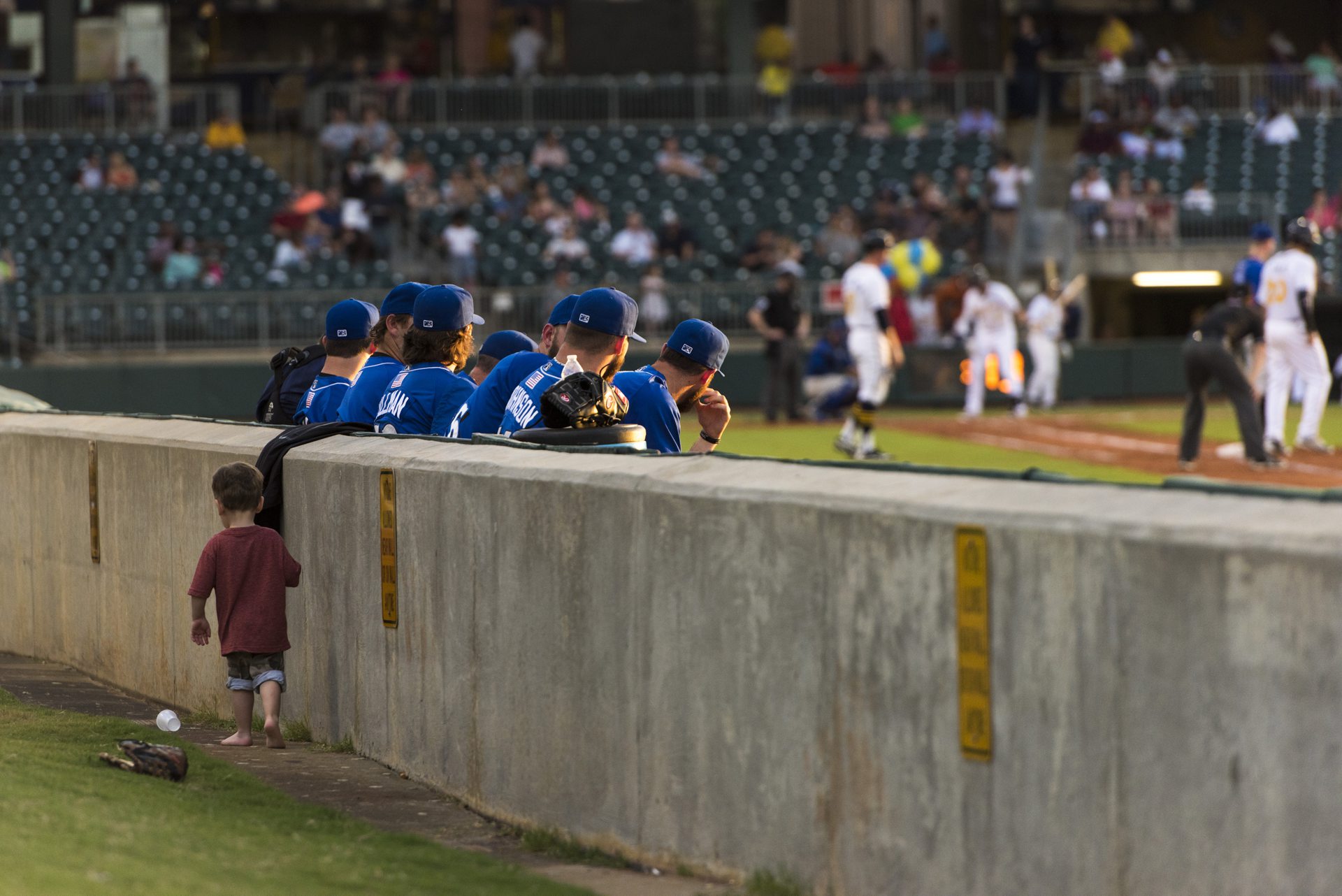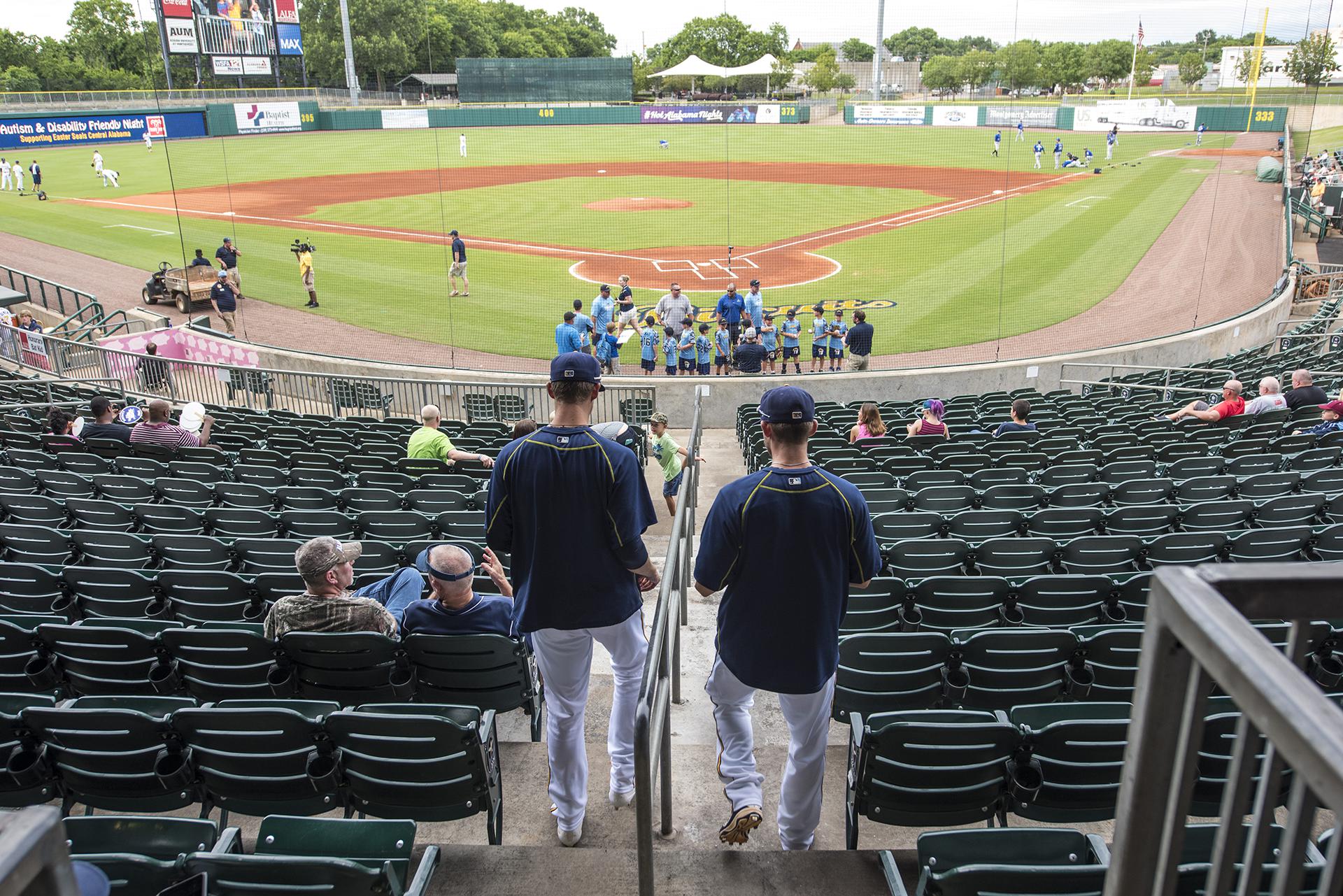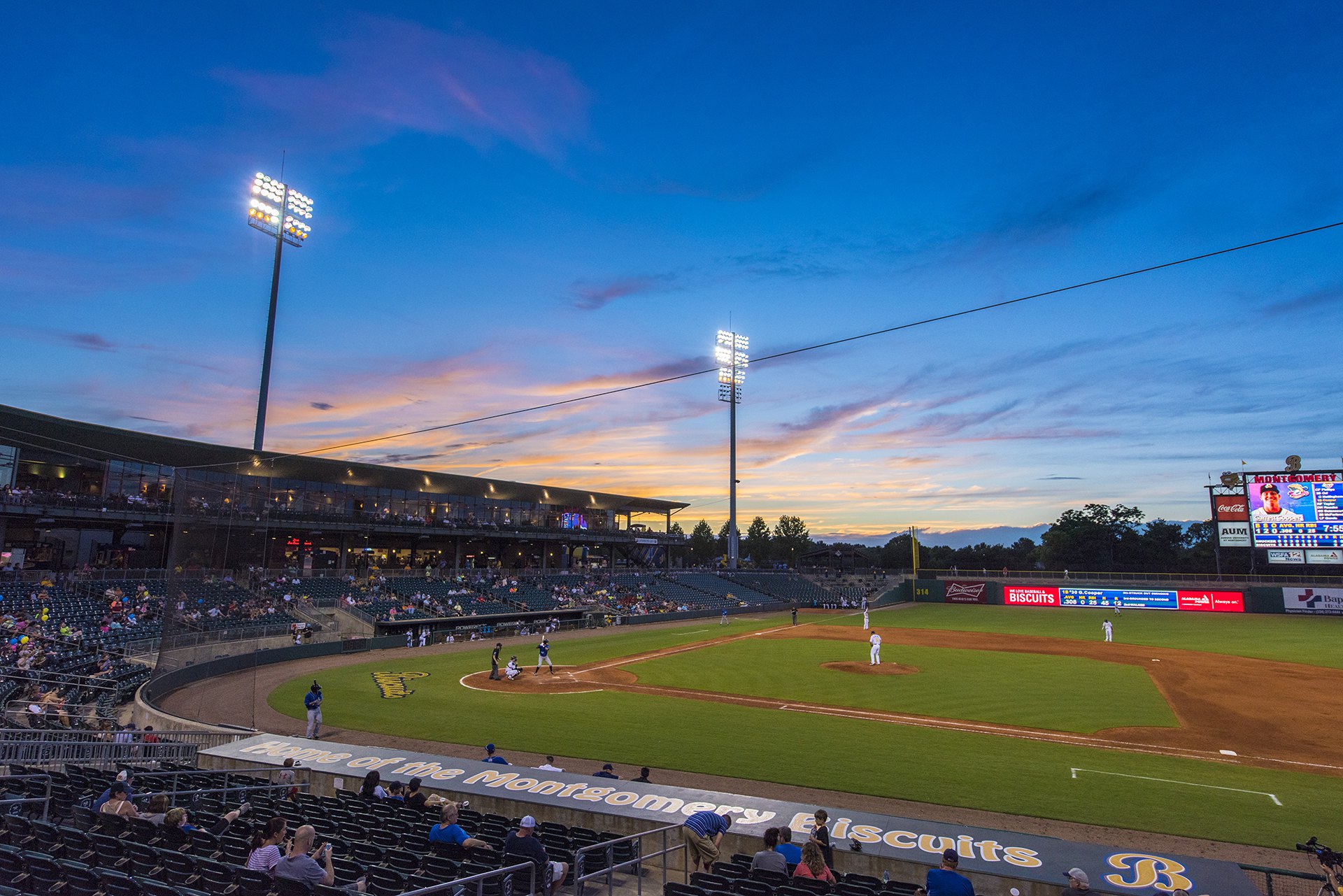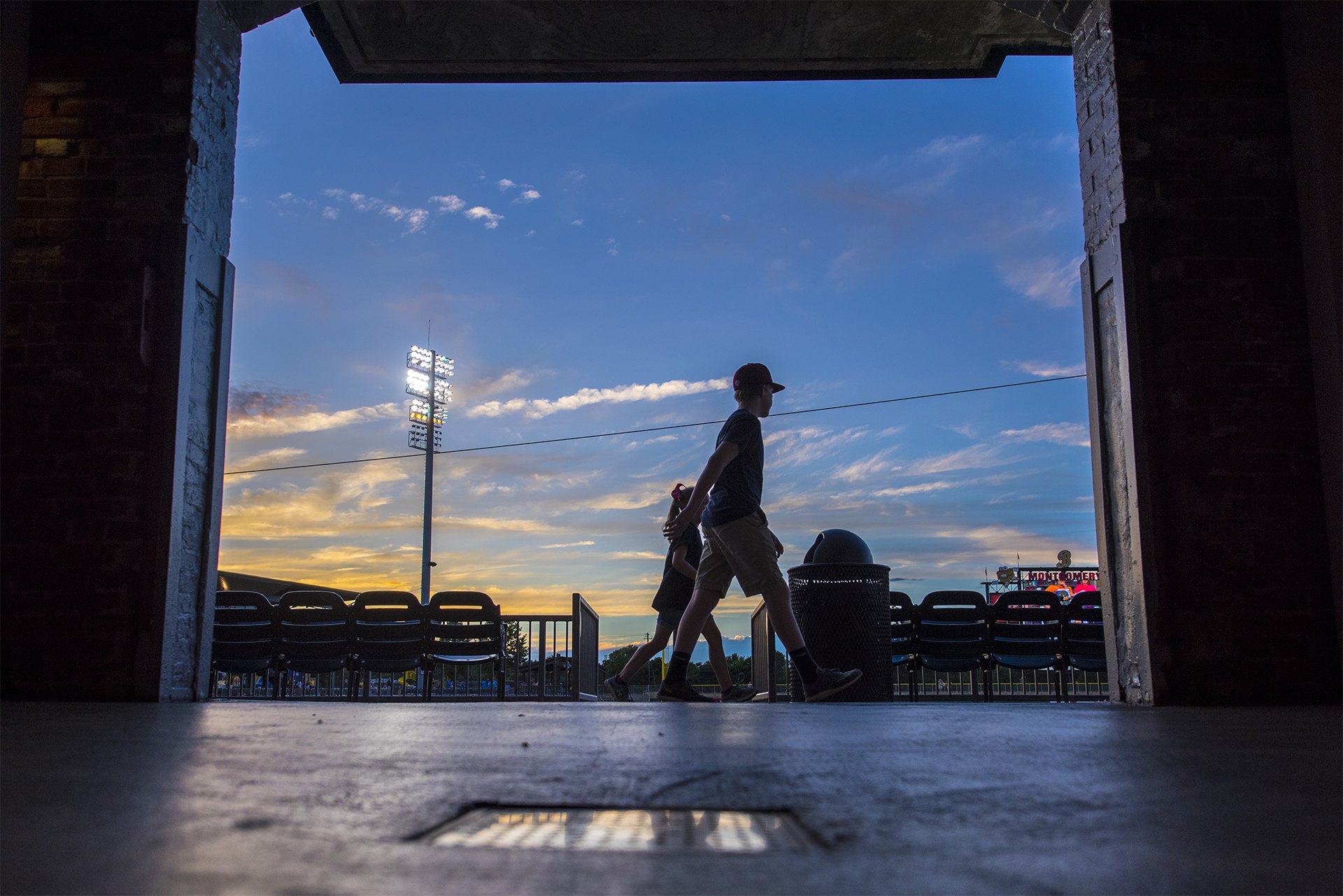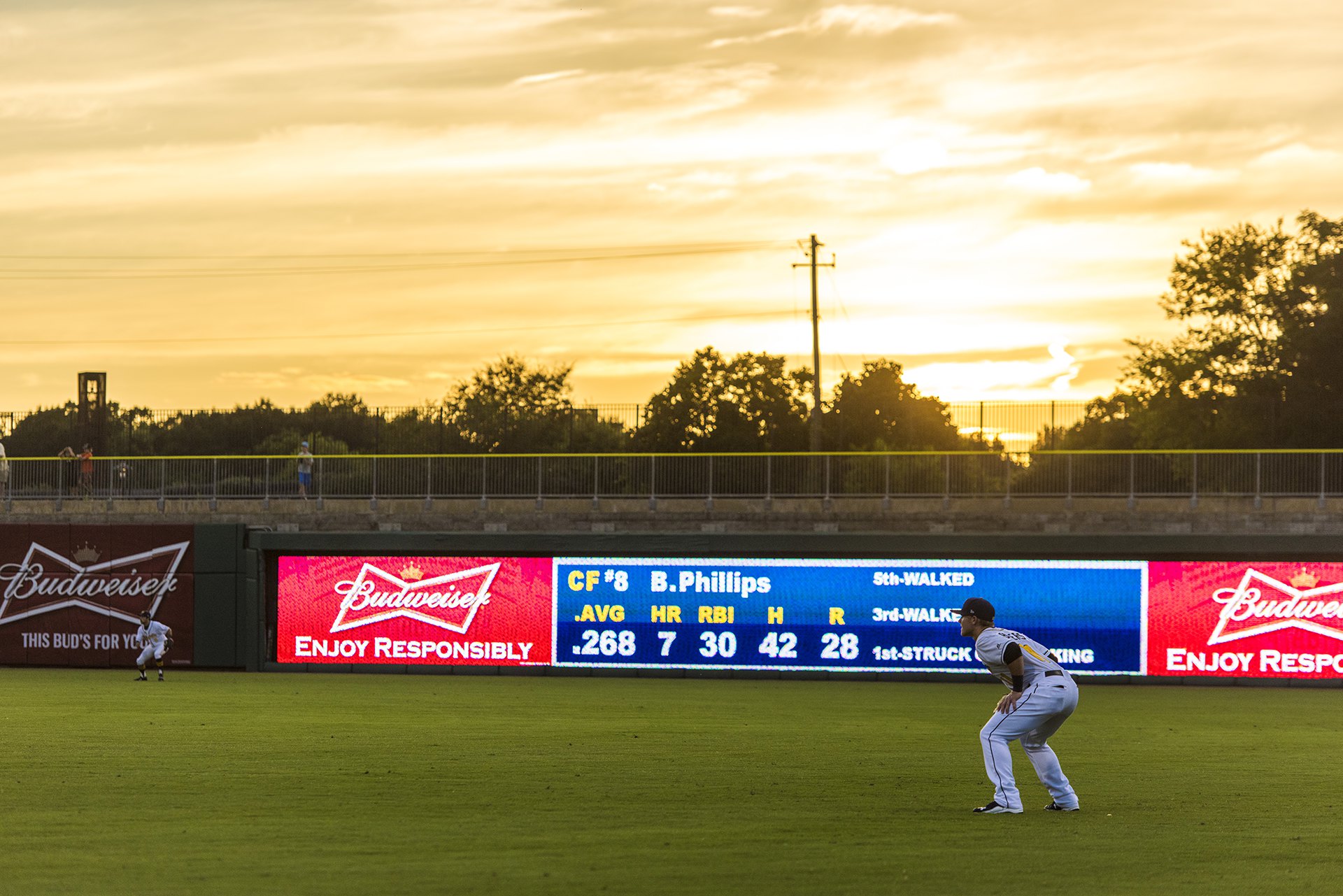Debates rage when public money goes to build sports facilities, and too many communities never see the promised economic benefits in return. But in downtown Montgomery, Alabama, a big stadium investment made 13 years ago appears to be paying off. Maybe it all happened because Montgomery named its team for something every Southerner can love: Biscuits.
Story by Jason Kahn | Photographs by Patrick Duffy
There’s a spot at the top of the stairs to the Alabama State Capitol where Jefferson Davis was sworn in as president of the Confederate States of America. A marker in the marble notes exactly where he stood to address the crowd.
One hundred four years later, and not so many paces away, is the spot where Dr. Martin Luther King Jr. stood after his long march from Selma, took the lectern and proclaimed, “How long? Not long, because the arc of the moral universe is long, but it bends toward justice.”
Jefferson Davis and Dr. Martin Luther King, Jr. Worlds apart, yet standing on the same staircase — the collision of the Confederacy and the Civil Rights Movement, at the cradle of both. That’s Montgomery, Alabama.
Dissonance still reverberates around this city. Directions to the Rosa Parks Museum include a left turn at the First Confederate White House. Under the Friday night lights each fall, fans cheer on George Washington Carver High as they take on the Generals from nearby Robert E. Lee High. The city where a bus boycott changed the world has almost no transit service today. It hosts one of the world’s largest annual Shakespeare festivals, yet struggles to teach students to read at grade level.
So when confronted with the hard problems American cities face today – inequality, unemployment, poverty, blight – the city decided that the answer, or at least part of it, was a baseball team named after a Southern staple: the Montgomery Biscuits.
Wait. What?
On the western edge of downtown, the Montgomery Biscuits take the field with an anthropomorphic biscuit named Monty emblazoned on their chests, googly eyes and all. Their colors? Navy blue and butter yellow. Their signature park fare? Biscuits, of course.
Sure, many cities have tried bringing in sports teams to build community, some even with silly names (see the late, lamented Savannah Sand Gnats). But the strangest thing about the Biscuits in Montgomery isn’t their name. It’s that such a silly scheme actually seems to be making a difference for the city.
In the past decade, these Biscuits have proven they’re not just fluff; their golden glow now radiates over nearby blocks, a formerly dark corner of the city. It has greased the skids for new bars, new restaurants, new hotels, new offices, new apartments, new investment, new life. It reaches up Dexter Avenue, toward the capitol building and its expansive steps, lighting the way to a new Montgomery.
The lights are on again downtown. All it took was finding the right Biscuit recipe.
You may not have been to Montgomery before, but you’ve certainly heard of it. The humble capital of Alabama has had an outsize role on the world stage – maybe more than a mid-size city ought to.
In 1861, when telegraphs brought news that a document opening with “We, the people of the Confederate States” was being signed, the news came from Montgomery. When Edward R. Murrow brought coverage of a bus boycott against Jim Crow, the coverage came from Montgomery. On Walter Cronkite’s broadcast in 1963, when the words “segregation now, segregation tomorrow, segregation forever” hung in the air, the words came from Montgomery. And when Huntley and Brinkley aired footage of marchers from Selma finally making it to their destination after weeks of perseverance, the footage came from Montgomery.
Yes, the Montgomery history reel overflows with iconic and at times infamous images. I’m not from Montgomery and don’t have family there. In fact, I only visited once, as a kid, before I became fascinated with the Biscuits. For me, and I’m guessing for many outsiders, the Montgomery film reel runs out of sometime in the mid-1960s. Shortly after filmmaker Ava Duvernay took us there for “Selma.”
But to the 350,000 people who call Montgomery home, it’s not stuck in some looping, monochrome slideshow last updated 50 years ago. It’s a living, breathing home. Life has continued in the city of Montgomery since it disappeared from international headlines and, except for its outsized number of historical markers, it’s your average, mid-sized American capital city. And just like so many of its peers, at some point life started moving to the suburbs.
Montgomery historian and preservationist Mary Ann Neeley, now in her 80s, has a lilt in her voice that makes good on Mark Twain’s promise that Southerners talk music. She was born in Montgomery and, with the exception of a “couple very brief interludes,” as she puts it, she’s been in Montgomery all her life. She’s been actively involved in the city’s preservation since the 1970s and is now regarded as an authority on the area’s history.
Montgomery was founded in 1819 when two competing towns along the Alabama River merged. The two towns had distinct street grids you can see on the map to this day. In 1846, the combined city became Alabama’s state capital.
I ask Neeley to take me through Montgomery’s more recent past – everything that happened since my film reel of local history ran out somewhere in the mid-’60s. She explains that, as in most good stories, we would need to start a bit earlier to get the full picture. So we rewound to the aftermath of World War II, when Montgomery’s downtown first started to wither.
It’s a familiar mid-century American story. So-called urban renewal brought Interstates 65 and 85 through the middle of town, destroying neighborhoods and forcing families to move out of the way. The newly opened roads siphoned rail passengers and freight traffic from downtown’s Union Station. The highways also widened access to nearby rural areas, making it possible to commute to work downtown. People started heading to greener pastures out of town.
As their customers moved to the suburbs, downtown stores followed. Alabama’s first shopping mall, the Normandale Shopping Center, opened 3.5 miles outside Montgomery’s downtown core in 1954, just as Dr. Martin Luther King Jr was getting started as pastor at the Dexter Avenue Church.
Over the next decade, foot traffic in the heart of the city fell as businesses closed up shop. When marchers came down Dexter Avenue in 1965 demanding equal voting rights, Montgomery Fair, Rosa Parks’ one-time employer and one of the largest stores in the city, had already left its downtown location vacant.
By the 1970s, downtown Montgomery was ghostly. While the suburbs thrived, “the heart of the city – the downtown – was struggling,” says Neeley. The feeling downtown was “real lonesome,” she remembers.
“Say that on Sunday afternoon, or sometimes even on Saturday afternoon, I could go down and lie in the middle of Commerce Street if I wanted to and I’d be perfectly safe – I wouldn’t be run over, I wouldn’t be assaulted, or anything else because there wasn’t anybody down there.” The handsome brick buildings from the late 19th and early 20th centuries stood vacant, crumbling onto quiet streets.
Something had to be done to bring life back to the heart of the city.
The first order of business in reviving downtown Montgomery was to reconnect it to its Alabama River waterfront. A rail line has long separated the city from the river, but a tunnel at the end of Commerce Street allowed pedestrians to easily access the water. Unfortunately, the tunnel worked both ways, allowing the water to easily access city streets during deluges.
After a particularly bad flood in 1930, the city bricked up the tunnel to protect the downtown from flood waters. A generation of Montgomerians grew up with little awareness a river even existed behind the railroad berm.
To start downtown’s revitalization in the mid-1970s, the city resolved to create tourism by reopening the tunnel and bringing in a riverboat, the Richard Montgomery, to ply the waters.
The city also made plans for a Civic Center to draw conventions and business downtown. Making room for the new construction required the demolition of historic buildings on the west side of Commerce Street.
Neeley and fellow preservationists bit their tongues in the name of progress and promises.
“I’ve never seen it written, but have been told this on many occasions, [there was] sort of an unwritten deal that preservationists wouldn’t howl about the west side of Commerce Street … and would not howl for the building of the Civic Center, if the other side of the street was preserved,” Neeley says. Demolition began and the Civic Center started rising.
All those convention-goers would need a place to rest, so plans were drawn up to convert an abandoned Western Freight train depot (itself on the site of a prison for Union soldiers during the Civil War) into a hotel.
Downtown Montgomery was on its way to revitalization. Well, sort of.
While the Civic Center did attract some meetings downtown, it didn’t create the kind of foot traffic needed to spur private investment.
Across the street, the eastern buildings were saved for preservation, as promised. While private enterprise did begin moving in and funded the restoration of buildings on the east side of the street, the new tenants were accounting or law firms that didn’t add to the area’s life after office hours.
Without lots of convention and tourist traffic, the hotel began a slow decline until finally shuttering in the early 1990s. And the Richard Montgomery riverboat proved to be “much too big for the amount of customers” in the area, according to Neeley.
In the end, there were a lot of “fine developments,” Neeley says, but “we just didn’t have that much going on downtown. … Nothing really had captured the whole attention.”
The downtown limped along, still mostly deserted at night and on weekends until a new mayor, Bobby Bright, arrived in 1999.
Mayor Bright wanted to get downtown Montgomery going again – but to do that, he needed an inspiring example that could make Montgomerians, by now both wary and weary of downtown revitalization efforts, believe again.
To anchor the new effort, Bright and the city decided to create a waterfront development and spur greater downtown investment eastward from there. The former prison-turned-depot-turned-hotel would turn a new leaf, as a baseball stadium drawing families downtown for affordable fun. Across the tracks along the river, the city would build an amphitheater to refresh the riverwalk with cultural events.
Montgomery launched a search for the right ownership team to bring a baseball team to town in a public-private partnership. The city would build and own Riverwalk Stadium, leasing it back to the team. The team, in turn, would repay the city through a percentage of revenue, all the while attracting enough people downtown to renew hope.
Whoever Montgomery selected would need to be savvy at the business of baseball as well as the business of community. To find the right fit, the city interviewed at least six potential owner groups, some with lots of experience in Minor League Baseball and some with none.
Through the process, they found Professional Sports Marketing, a company based in Illinois and owned by Sherrie Myers and Tom Dickson. By 2002, their company already counted three minor league teams in its portfolio – the Lansing (Michigan) Lugnuts, the Dayton (Ohio) Dragons, and the Charleston (West Virginia) Alley Cats, and had helped develop stadiums in Gary, Indiana, Eastlake, Ohio, and Joliet, Illinois. The group also had a track record of building successful teams while delivering on economic development promises in the surrounding communities.
“We try to go and meet the [city leaders] way in advance of when the stadiums will be built,” Myers says. A Chicagoan, she has enough Kansas City and Oklahoma roots to make it sound natural when she slips “y’all” into a conversation. She and Dickson must have made good impressions; Professional Sports Marketing was awarded the project in 2002, and stadium construction began with a plan to be done in time for the 2004 season.
With their Montgomery deal in place, Myers and Dickson just needed a team for Montgomery.
Four hundred miles away, at the same time, the Orlando Rays were looking for a new home. Their move out of downtown Orlando to Disney's Wide World of Sports a few years prior had done a number on attendance. Professional Sports Marketing put a deal together to buy the Orlando Rays and bring them up to Alabama.
With a team and stadium locked in, it was time to pick a name.
“If these Minor League teams are going to really be a part of the community,” Myers says, “it needs to be named something that will work.” The team wanted something inclusive and fun, but also merchandisable. A team’s name is critical to its long-term success – marketing, publicity, merchandising and community building all hinge on having a name that strikes a chord.
As they had done in other cities, Professional Sports Marketing asked Montgomery-area residents to submit ideas for the team’s new name. Suggestions poured in – “Senators” (because Montgomery is the state capital), “Mockingbirds” (for Harper Lee), “Express” (for the train heritage) and hundreds more. Also in the pile was a suggestion from a fellow named Tripp Vickers. His idea? The Biscuits.
Myers consulted with local authorities, including Neeley, on the potential choices. Biscuits was the clear winner.
“It was just perfect,” Myers remembers. “It wasn’t the east side of town or the west side of town or whatever. It was just Southern.” And with that, the Biscuits became the nation’s only Minor League baseball team named for a baked good.
On Memorial Day weekend in 2003 at a public concert downtown, the owners unveiled the team’s name. After the announcement, “you could hear a pin drop,” says Myers. People expected something serious and tough. “Biscuits” is anything but that.
The Biscuits’ logo is Monty the Biscuit, an anthropomorphized biscuit with arms, legs, and a pat of butter for a tongue. Some might say you just want to eat him up. On gameday, mascot Big Mo delights fans at the park. He’s a “Biscuit-lovin’ beast” who looks something like an anteater – but with an elephant trunk and goofy grin. At 7 feet tall, he weighs “more than a baker’s dozen,” according to the team. Indeed, the biscuits appear to have gone to his hips.
It only took a dash of national press to have folks around town rise to the occasion and start embracing the team and its new, starchy mascot.
“Now you can’t find anyone who doesn’t like the name Biscuits. They’re proud of it and beat their chest for it,” says Myers. “Jimmy Fallon even likes the name.” Thirteen years later it’s still earning accolades; just last year, Sporting News declared the Biscuits the best name in the Minors, based on reader votes and an expert ranking.
“If we had named it the Mockingbirds or something like that, it wouldn’t have made the Washington Post,” says Neeley, with a chuckle. “The name really has given it a uniqueness that everyone’s accepted. We grew up with biscuits, we eat biscuits, and they just belong in Montgomery. It’s turned out very, very well I think.”
Indeed, it has turned out very well. Going to a Biscuits game today is a rollicking good time.
You enter Riverwalk Stadium above the stands, like you would in a big league park (a conscious design choice to lower the height of the field so you wouldn’t have to walk up to your seats). There’s a giant video board to reinforce that Major League feel; added in 2012, it’s one of the largest in the League.
That Major League touch doesn’t carry over to the box office, though. As promised, Biscuits games are very affordable; tickets start at $9 and top out at $13. Myers explained that it’s priced to be competitive with a family night out at the movies. She knows the team is not in the baseball business, but the family entertainment business.
The Biscuits averaged 3,500 fans at each of the 70 home games last season. And while baseball is the focal point, there’s a lot more going on. There’s a picnic area on the first-base line with room for the little ones to run around, a walking path around the outfield under the scoreboard to stretch your legs and a playground area beyond third base, complete with a bouncy house and batting cage for kids.
Between innings, the crowd lights up for the usual fan-cam antics you might find at any ballpark, but also for on-field karaoke contests, the team’s theme song (a campy sing-along called “Bring on the Biscuits”), and a biscuit cannon. Yes, you read that right. They shoot biscuits from an air cannon into the crowd. Don’t worry: They’re wrapped and still very edible on arrival.
If flying biscuits aren’t your thing, you can head to the concourse to pick up yours in a more traditional manner. They’re $3.75 for two with all of the super-sweet ALAGA syrup (the “Sweetness of the South,” produced down the street since 1906), butter or jelly you want. For slightly more dough, you can add fried chicken, gravy or strawberry shortcake fixings. And the biscuits are actually pretty good. Buttery, fluffy, just the right amount of flake and fork-splittable. Delicious.
Adam Richman of Food Network’s “Man vs Food” recognized the park’s chicken biscuit with ALAGA as one of the top five ballpark foods in the country – Major or Minor League. Fans tell me the Polish sausage and nachos also get high marks. New the last few seasons: gourmet grilled cheese, house-smoked pulled pork (recommended) and ice-cold ICEEs, a real hit for all ages at the height of a Montgomery summer. It’s no coincidence that the food rates highly with fans and visitors alike.
You can also check out the Biscuit Basket, the team store behind home plate. A visual pun bonanza, the store is set up like a bakery, with merchandise displayed on antique ovens and chef’s tables. They have stuffed Monty the Biscuit, Biscuit hats (think Green Bay cheeseheads, but a biscuit) and Big Mo printed on just about any object you could want.
Around the park, the team’s year-round staff of 30 employees, plus the roughly 200 seasonal employees, make the park experience exceptional. Southern hospitality rules with a smile. Even the ticket takers and suite-level “bouncers” are pleasant.
Talking with fans, it’s obvious many are there for the baseball. But an equally large contingent is not. These fans cite the stadium’s food, its atmosphere or getting to spend time with friends outdoors as the main draws for them. They just like being out in the community. In fact, Staci Wilkenson, marketing director for the Biscuits, confides that some fans leave the game without even knowing who won: They just enjoyed a night out in the warm Montgomery air among family, friends, and the community.
More than any other professional sport, Minor League Baseball is about the entertainment and experience as much as what’s happening on the field. The Biscuits are just one stop on a player’s six-level journey from the Rookie League to the Tampa Bay Rays (the Biscuits’ Major League affiliate). Players are drafted into the farm system by Tampa Bay, and the Rays manage players throughout, deciding when a player is ready to move up to the Biscuits’ Double-A level and when they’re ready to move on. The lineup churns throughout the season. But even as the players cycle in and out, fans can be assured the Biscuits staff will keep smiling, the food will still be top notch, and the park experience will remain outstanding.
Part of Professional Sports Marketing’s pitch to Montgomery was its experience in building community around a ballpark. But Montgomery broke their model a little bit.
First, there was more competition for people’s time in Montgomery than in other cities. Myers cites survey data that, on average, Montgomery families visit church 2.5 times each week. Local weather allows youth recreational sports all year long. And the Gulf isn’t that far south when beach weather comes around each summer. Ultimately, Myers says “their families, their church and their kid’s activities to me seem like a higher priority than [we’ve] seen in other markets.” The team has had to work hard to offer entertainment that takes into account those priorities.
Second, the city had some of that classic Southern distrust of something new. When the team was getting started, some customers calling in to the Biscuits sales office wanted to understand the team’s intentions and values before committing to a season ticket.
“The sales reps were selling season tickets and one came back and said ‘This guy is inclined but he wants to know, do you go to church?’” remembered Myers. “I’ve never been asked that before. [Montgomerians] want to make sure they understand who they're doing business with and what you're about and they're not easily swayed or sold. Snake oil is not something they’re buying into.”
Now, the calendar is full of special promotions and events to keep locals coming back. Many come from Professional Sports Marketing’s template for building a team, but all are tailored for Montgomery.
- Tuesday is $1 hotdog night.
- Wednesday brings discounts for active and retired military personnel, in a nod to nearby Maxwell Air Force Base (and to the fact that attendance would otherwise drop on Wednesdays, a popular night for mid-week activities at some churches).
- Friday fireworks were expanded to Saturdays and holidays, too – Montgomery loves its fireworks, according to team feedback surveys.
- The season calendar also includes NASCAR nights, Faith Nights, College Nights for local high schools and a night for the Montgomery-area Future Farmers of America — not events that you’ll find on the schedule at many other ballparks.
Also on the team’s calendar are three 10:35 a.m. Grand-Slam School Day games. A parade of yellow buses brings 5,000 K-12ers to the park to shout along to Spongebob Squarepants theme, sing “Let It Go” from “Frozen,” cheer on Big Mo and maybe watch some baseball. They’re also there to supplement their classwork – the team provides schools with a custom curriculum aligned to state standards to prepare for the game. For instance, middle schoolers might work on math problems about expenses for an away game, while elementary students practice reading about baseball.
The Riverwalk Stadium seems to have a new idea coming out of the oven every time you turn around.
Meanwhile, outside the stadium, downtown has been slowly but surely changing. The arrival of baseball and the fans parading around the area made it possible for people to believe in life downtown. It increased foot traffic and became the catalyst it was intended to be for private development and additional public effort downtown.
Buoyed by the new Biscuits stadium and riverwalk improvements, Mayor Bobby Bright worked with a design firm, engineering consultants and the Montgomery community to create a master plan for downtown growth, released in January 2007. The plan called for development to branch out from the stadium and work its way throughout downtown.
Progress on the master plan got underway with the restoration of Court Square in April 2007. A cobblestone roundabout replaced what would otherwise be a five-way intersection, a relic of the city’s original street grids. The city’s historic cast-iron fountain, first installed over a spring in that spot in 1882, sits in the middle of the roundabout. Planners intended the plaza to be the “first true plaza built in the United States in more than 80 years,” according to city releases from the time, to prepare the area for public use and private development. The project earned Mayor Bright an Urban Design Award from the Alabama Chapter of the American Planning Association.
In 2008, the now-aging 1970s Civic Center was replaced with a new convention center plus a performing-arts space. Attached to the center is a Renaissance Hotel (with “inspiration from New York’s Plaza Hotel,” according to its architects). A new waterfront riverboat also arrived, the Harriett II.
When Mayor Bright, a Democrat, set his sights on D.C. in 2009 and was elected to represent Montgomery’s district in Congress, the city elected Republican Todd Strange. Despite hailing from a different party, Mayor Strange kept executing the same development plan for downtown.
“Prior to being the Mayor, [Strange] was chairman of the county commission.” says Mac McLeod, director of business and commercial development for Montgomery. “[The mayoral change] was transparent from that standpoint; he just took it and ran.”
Mayor Strange “really accelerated the highest priorities of the plan,” agrees Myers. “We didn’t miss a step in that change”
Under the Strange administration, the city has gotten more involved in speeding up development. In 2010, with a grant from the state, Mayor Strange’s administration bought up several abandoned properties on lower Dexter Avenue and has since resold them to developers at a discount – contingent on their developments meeting specific deadlines. Montgomery Finance Director Barry Crabb told the Montgomery Advertiser the discounts were worth it: “If somebody wanted to give us $4 million for (One Court Square) and just sit on it, we wouldn’t be as interested in that.” The Advertiser reported the ultimate goal was “to spur development, not to make a profit on property sales.” Restaurants and stores are opening in formerly empty properties, and new apartments are replacing former parking lots.
An additional two entertainment districts have been added to spur investment in nightlife, resulting in a new development called the Alley, connecting the Riverwalk Stadium to Commerce Street with a “New Orleans-style” alley of shops, restaurants and lofts. All with job openings for Montgomerians.
To the northeast, the barracks-like Trenholm Court housing project has been demolished to make way for a new mixed-income housing neighborhood better integrated into the city grid with more parks and greenspace.
And just in time for last year’s 50th anniversary of the Selma-to-Montgomery Voting Rights March, Montgomery revamped the Five Points intersection along that route and reclaimed parking in front of the State Capitol Park to transform it into green space, just as the Downtown Redevelopment Plan called for. Things are really on the rise.
Still, much more remains to be done.
Some think progress is too slow as the Biscuits play their 13th season in the city. Others crave more variety in new developments: A bar with something live other than acoustic guitar? Maybe some Thai food? What about basketball? The city planning office knows it needs to attract a grocery store to really make downtown complete for new residents. Blocks of blighted or abandoned buildings remain. Poverty still pervades parts of the city. Citizens worry if Montgomery’s education system can prepare their children for the future.
But at the end of the day, nearly everyone agrees, the revitalization plan has helped the city. While there are legitimate concerns about specific implementation steps, people are engaged in the process, and that’s progress.
There’s a lot to worry about and lots of work left to do. But at Riverwalk Stadium, sharing a biscuit and watching the lights glint off the new Montgomery downtown, there’s hope. Hope that more families will move back downtown. Hope that Montgomery can attract more industry to create more opportunities for everyday Montgomerians. Hope that more tourists come to learn about the important moments in Southern history that happened here. Hope that this humble city on the Alabama River can once again inspire us as we struggle with the dissonance of our high ideals in a still-imperfect reality.
One question gnawed at me. Over the years, Myers and her organization have worked with nine teams, but they’ve since sold them all off except their first (the Lansing Lugnuts) and the Biscuits. Why? Why does Myers keep coming back to Montgomery for 10 days a month after all these years?
When we first talked on the phone, Myers said that she was “personally motivated to work and give hard because of the way they’ve given to me.” In person at the Riverwalk Stadium, she continued, “It didn’t feel like the work was done. It’s never really felt like the right time.”
I believe it runs a little deeper. In figuring out the Montgomery market, Myers spent so much time and effort trying to understand the community that she ended up becoming part of it. She’s worked with the Montgomery County Schools superintendent on how the team might help improve graduation rates. And with the Chamber of Commerce president on growth plans for downtown. And with local pastors on how to entice kids off the street and into a game. The point of all this isn’t to just sell another ticket; it’s about a responsibility to the community.
Case in point: For the team’s 10th anniversary, the owners wanted to add a live animal mascot. Everything Biscuits starts and ends with the community, so Myers called the Alabama Department of Agriculture to find an indigenous animal that would be authentically local. And, of course, the name for this new mascot would be selected from community submissions – you have to keep going “back to the community and find out what people need,” Myers says. Apparently, what they needed was an Alabama micro-potbelly pig named Miss Gravy, Duchess of Pork. Her highness now holds court at Riverwalk Stadium.
Myers jokes that the team is so in touch with what the city needs that Mayor Strange treats her like a city department.
“We joke about it,” she says. “He says ‘So you know you think you’re a department of the city,’ and I say, ‘Yeah, but sir, I just don’t report to you.’”
Her passion for the community was clear every time Myers entered a stadium suite on a Grand-Slam School Day when I visited. Sponsors had brought students from local schools to their suites on a gorgeous Montgomery spring day.
“Hey y’all. How are you?” she said. “I heard y’all had Noah’s Ark last week. The weather’s so nice today it’s clear to me that God must love baseball.”
She’d then catch up with familiar faces and make sure the suite owners were satisfied with their experience. Or agree to photos with students and teachers who whispered excitedly, “That’s the Biscuits lady from TV.” Or get into a deep discussion about the latest standardized testing results with a local principal.
Myers, who remains technically an Illinois resident, is now so tightly connected to Montgomery that last year she served on Leadership Alabama, working on problems affecting the state.
"The responsibility that comes with running a team, it’s an obligation to the community,” she says. “We make a difference in these communities. As a person, they have treated me very nicely and inspired me to want to continue to give back.
“Once you earn the right to be respected by them, they hold you up. Once they finally endorse it you can’t fail,” says Myers. “They’re not going to let you.”
In 2014, the Montgomery Biscuits were honored by Baseball America and Minor League Baseball in their Bob Freitas Awards as Organization of the Year in Double-A baseball. It’s an award for sustained excellence in operations.
"We're ecstatic our own Montgomery Biscuits were chosen to receive this prestigious honor,” said Mayor Strange at the time. “The Biscuits' history over the past 11 seasons exemplifies a successful Minor League baseball operation, and that has been a catalyst for economic development for the River Region."
It may have taken a while to get rolling, but a vibrant Montgomery downtown is finally starting to rise. The arrival of the Biscuits brought something for the community to do together downtown, increasing foot traffic and spurring further investment, ultimately making a vibrant Montgomery downtown a real possibility again. All because of a baseball team, some quick breads, and a basketful of dedicated people.
The Biscuits are ready and Montgomery is eating them up.













